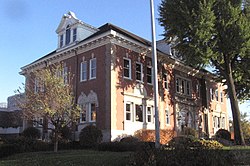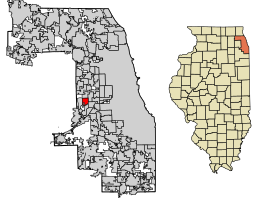LaGrange, IL Florist | Same Day Flower Delivery IL 60525

Flower Delivery to LaGrange, Illinois - LaGrange Florist
La Grange, Illinois
|
La Grange, Illinois
LaGrange
|
|
|---|---|
| Village of La Grange, Illinois | |

La Grange Village Hall
|
|
| Etymology: French: la grange (the barn) |
|
| Motto(s):
Tradition & Pride - Moving Forward[1]
|
|
| Anthem: My La Grange by Jimmy Dunne [1] | |

Location of La Grange in Cook County, Illinois
|
|
| Coordinates: 41°48′29″N 87°52′24″WCoordinates: 41°48′29″N 87°52′24″W | |
| Country | United States |
| State | Illinois |
| County | Cook |
| Township | Lyons Township |
| Settled | 1830 |
| Incorporated | June 11, 1879 |
| Founded by | Franklin Dwight Cossitt |
| Named for | La Grange, Tennessee, in turn named after the ancestral home of Marquis de Lafayette[2] |
| Government | |
| • Village president | Thomas E. Livingston[3] |
| • Trustees[3] | Malia Arnett Bill Holder Michael Kotynek Mark Kuchler Lou Gale David Mc Carty |
| Area | |
| • Total | 2.52 sq mi (6.54 km2) |
| • Land | 2.52 sq mi (6.54 km2) |
| • Water | 0.00 sq mi (0.00 km2) 0% |
| Elevation | 646[5] ft (197 m) |
| Population
(2010)
|
|
| • Total | 15,550 |
| • Estimate
(2019)[6]
|
15,322 |
| • Density | 6,068.12/sq mi (2,343.08/km2) |
| Demonym(s) | La Granger[2] |
| Time zone | UTC-6 (CST) |
| • Summer (DST) | UTC-5 (CDT) |
| ZIP Code(s) |
60525
|
| Area code(s) | 708 |
| FIPS code | 17-40767 |
| Wikimedia Commons | La Grange, Illinois |
| Website | www |
The village of La Grange (/lə ˈɡreɪndʒ/ lə GRAYNJ; often spelled LaGrange), a suburb of Chicago, is a village in Cook County, in the U.S. state of Illinois.[7] The population was 15,550 at the 2010 census.[8]
History[edit]
The area around La Grange was first settled in the 1830s, when Chicago residents moved out to the west due to the rapid population increase in the city in the decade since its incorporation. The first settler, Robert Leitch, came to the area in 1830, seven years before the City of Chicago was incorporated. La Grange's location, at approximately 13 miles (21 km) from the Chicago Loop, is not considered far from the city by today's standards, but in that time the residents enjoyed the peace of rural life without much communication with urban residents.
The village was officially incorporated on June 11, 1879. It was founded by Franklin Dwight Cossitt, who was born in Granby, Connecticut, and raised in Tennessee, and moved to Chicago in 1862 where he built a successful wholesale grocery business.
In 1870, Cossitt purchased several hundred acres of farmland in Lyons Township, along the Chicago-Dixon Road, known today as Ogden Avenue (U.S. Highway 34). Ogden Avenue, on the site of a defunct Native American trail, was also referred to as the "Old Plank Road". Planks were often stolen by settlers to be used as building material, which made traveling very bumpy. When the Chicago, Burlington & Quincy Railroad came to town, La Grange was a milk stop called Hazel Glen. A few miles to the south, through present-day Willow Springs, the Illinois and Michigan Canal had emerged as a major shipping corridor, connecting Chicago and the Great Lakes with the Illinois and Mississippi rivers.
Cossitt set out to build the ideal suburban village - laying out streets, planting trees, donating property for churches and schools, and building quality homes for sale between $2,000-$8000 USD.[9] He also placed liquor restrictions in the land deeds he sold to prevent the village from becoming a saloon town.
When Cossitt began his development, the area was served by a post office known as Kensington. But upon learning of another community already with that name in Illinois, Cossitt decided to name his town in honor of La Grange, Tennessee, where he had been raised as a youth on an uncle's cotton farm. To this day, Kensington remains the name of one of the village's major avenues.
After the Great Chicago Fire of 1871 destroyed much of that city, thousands of its citizens sought new homes and opportunities far from the city's ills but within a convenient commute. La Grange was ideally situated to accommodate them.
Telephones were first set up by Dr. George Fox in the 1880s for quick communication between his home office and a drug store, enabling him to order prescriptions to be delivered by buggy in a moment's notice. Growing to 52 lines in 1894, it increased twofold to 120 by the next year, and surged to 2,346 by 1921[2] (36 percent of the population at the time).
There was a large spike in population around 1890 when the village was still relatively young, while the population has been slowly declining since the '70s.
Geography[edit]
La Grange is located at 41°48′29″N 87°52′24″W (41.807938, -87.873455),[10] about 13 miles (21 km) west of Chicago. The village is roughly flat, only deviating from the elevation of 645 feet by at most ten feet. La Grange is surrounded by incorporated places of similar sizes on all sides except to the South West, where the generously-named La Grange Highlands are.
According to the 2010 census, La Grange has a total area of 2.52 square miles (6.53 km2), all land.[11] Two major railroad tracks run through the village, including the Burlington Northern Santa Fe, and the CSX/Indiana Harbor Belt lines.
Some 14,000 years ago, the land under La Grange sat on the western shore of Lake Chicago, a predecessor to Lake Michigan.[12] The prehistoric shoreline today is delineated by Bluff Avenue, a north-south street on the village's east side.[2]
Demographics[edit]
| Historical population | |||
|---|---|---|---|
| Census | Pop. | %± | |
| 1880 | 531 | — | |
| 1890 | 2,314 | 335.8% | |
| 1900 | 3,969 | 71.5% | |
| 1910 | 5,282 | 33.1% | |
| 1920 | 6,525 | 23.5% | |
| 1930 | 10,103 | 54.8% | |
| 1940 | 10,479 | 3.7% | |
| 1950 | 12,002 | 14.5% | |
| 1960 | 15,285 | 27.4% | |
| 1970 | 17,814 | 16.5% | |
| 1980 | 15,693 | −11.9% | |
| 1990 | 15,362 | −2.1% | |
| 2000 | 15,608 | 1.6% | |
| 2010 | 15,550 | −0.4% | |
| 2019 (est.) | 15,322 | [6] | −1.5% |
| U.S. Decennial Census[13] | |||
As of the census[14] of 2000, there were 15,608 people, 5,624 households, and 4,049 families residing in the village. The population density was 6,220.7 people per square mile (2,400.9/km2) This is mainly due to the Village Plan aiming to prevent overcrowding and to keep population density at a level consistent with the quality of life envisioned by Franklin Cossitt.[2] There were 5,781 housing units at an average density of 2,304.1 per square mile (889.3/km2). The racial makeup of the village was 91.02% White, 6.02% African American, 1% Asian, 0.09% Native American, 0.02% Pacific Islander, 0.99% from other races, and 0.86% from two or more races. Hispanic or Latino people of any race comprised 3.66% of the population.
The top five ancestries reported in La Grange as of the 2000 census were Irish (25.2%), German (24.8%), Polish (10.5%), Italian (10.2%) and English (9.7%).[15]
There were 5,624 households, out of which 37.9% had children under the age of 18 living with them, 60.3% were married couples living together, 9.2% had a female householder with no husband present, and 28.0% were non-families. 24.5% of all households were made up of individuals, and 9.7% had someone living alone who was 65 years of age or older. The average household size was 2.67 and the average family size was 3.23.
In the village, the population was spread out, with 28.5% under the age of 18, 4.8% from 18 to 24, 29.4% from 25 to 44, 23.8% from 45 to 64, and 13.5% who were 65 years of age or older. The median age was 38 years. For every 100 females, there were 94.2 males. For every 100 females age 18 and over, there were 87.4 males.
The median income for a household in the village was $80,342, and the median income for a family was $95,554. Males had a median income of $62,030 versus $41,260 for females. The per capita income for the village was $34,887. About 3.2% of families and 4.0% of the population were below the poverty line, including 4.3% of those under age 18 and 4.4% of those age 65 or over.
Economy[edit]
Business and commerce[edit]
|
This section does not cite any sources. (April 2012) (Learn how and when to remove this template message)
|
La Grange is the mailing address for the headquarters of Electro-Motive Diesel, formerly General Motors' Electro-Motive Division, a major manufacturer of railroad locomotives and diesel engines. The headquarters, engineering facilities and parts-manufacturing operations actually are located in the adjacent village of McCook; originally, the locomotives were also built there, but in more recent years final assembly has moved to EMD's other facility in Muncie, Indiana.
The downtown area, centered along and around La Grange Road (US 45) and the BNSF Railway line, grew somewhat run-down during the 1980s; however, the mid-to-late 1990s saw a revival, with many new businesses opening including Trader Joe's. Many of these new businesses are restaurants; La Grange draws much of this business from the neighboring town of Western Springs, since Western Springs did not allow the sale of alcoholic beverages in restaurants until recently. In June 2006, animal statues were placed around the downtown area, mimicking the famous Chicago Cows.
This expansion of the downtown led to increased congestion; often, parking became difficult to find, especially on weekends. One proposal to remedy this was the building of a parking garage in a current parking-lot area; some very vocal residents, however, opposed this as a waste of tax dollars. Eventually, a referendum on the parking garage was passed; ground was broken on March 3, 2005. The parking structure is now complete and operational. The parking structure was paid for by a grant from the state for the advancement of public transportation (since increasing parking for train commuters would increase the number of people willing to use the train). The upkeep is paid for by an increase in the sales tax at restaurants and other entertainment establishments. There was no increase in the local property taxes.
Arts and culture[edit]
La Grange holds numerous public activities and festivals. Art fairs, historic housewalks, carnivals, and farmer's markets are also common, mostly taking place in the downtown area.
Pet Parade[edit]
An annual event known as the Pet Parade has been conducted every year since 1947 and attracts thousands of people from the La Grange area. The parade marches through downtown and includes a wild variety of animal pets like dogs, cats, hamsters, birds, and farm animals. There is a long history of Grand Marshals for the parade including Elephants and Donkeys from the Brookfield Zoo (1948), Luci Baines Johnson – Daughter of the President Lyndon B. Johnson (1964), and Susan Dey and Danny Bonaduce of “The Partridge Family” (1971). Included in the long history of the event is the Pet Parade Queen; including Erin Vondrasek - Daughter of Jim and Mary Vondrasek (2001).
In 2019 the theme for the Pet Parade was 'Celebrating the Heroes and Superheroes' and drew an estimated 15,000 people. The theme for 2020 is 'Roaring 20's: Then and Now'.
Architecture[edit]
A few homes in town were designed by Frank Lloyd Wright. There is even a "bootleg" house, one he designed on the side, contrary to his employment agreement, when he was supposed to be working exclusively for architect Louis Sullivan. Wright was reportedly fired over this and similar employment agreement infractions.
Government[edit]
|
This section does not cite any sources. (April 2012) (Learn how and when to remove this template message)
|
The Village of La Grange is a non-home rule municipal corporation and operates under a board-manager form of government. A seven-member board of trustees, elected as provided by state law, serves four-year overlapping terms. A village manager is appointed by the board.
The village has six operating departments: administration, finance, police, fire, community development and public works.
The village is in Illinois' 3rd congressional district, and is represented by Marie Newman, a resident of the village.
The village is served by the Park District of La Grange with a five-member board of commissioners, elected as provided by state law, which serves four-year overlapping terms. An executive director is appointed by the board.
Endorsing organizations[edit]
The longest-lived continuing endorsing organization in La Grange is the Citizens' Council.[16] As all such organizations under the village manager form of government, it is non-partisan. The council in particular seeks, evaluates, and recommends candidates for the village, library and park district boards.
Other non-partisan slating organizations form periodically to seek and support candidates for the various elected boards.
Education[edit]
Public schools[edit]
La Grange has public elementary schools, including two of the four schools in LaGrange Elementary School District 102: Cossitt School (named after Franklin Cossitt) and Ogden Avenue School (named after the local name for U.S. Route 34, which in turn is named after William Butler Ogden, first mayor of Chicago). Park Junior High is also part of District 102, but is located in La Grange Park, Illinois. La Grange Elementary School District 102 also includes Forest Road Elementary in La Grange Park, and Congress Park Elementary in Brookfield. Two other elementary schools in La Grange are part of La Grange Elementary School District 105: Seventh Avenue School and Spring Avenue School, both located on the streets that share their names. Gurrie Middle School also serves District 105. Some students in the southwest portion of La Grange are serviced by Highlands Elementary School and Highlands Middle School in nearby La Grange Highlands, part of La Grange Highlands School District 106.
St. Cletus and St. Francis Xavier serve as the two Roman Catholic schools in La Grange. St. John's Lutheran is the one Lutheran elementary school within the village limits.
Lyons Township High School in La Grange, founded in 1888, now has two campuses. North Campus, located in La Grange, is used by Juniors and Seniors and was the original high school. Freshmen and Sophomores go to South Campus, founded in 1956, located in neighboring Western Springs. The Campus was split due to lack of available land for expansion around the original building. Previously there also was a junior college associated with the high school but due to increasing enrollment, lack of space, and new rules that separated junior colleges from high schools, it was merged with College of DuPage in 1967. When it was open, Lyons Township Junior College was nicknamed Tick-Tock Tech, due to its location near the clock tower.
Media[edit]
|
This section does not cite any sources. (July 2018) (Learn how and when to remove this template message)
|
One of the newspapers of La Grange is The Doings,[17] a subsidiary of the Chicago Tribune.
Lyons Township[edit]
Lyons Township High School by far provides the most media outlets. The first one established, LION Newspaper, was founded over a century ago and distributes news to all over the district. The second form of media, WLTL, first aired in 1968 and has been broadcasting music for fifty years. LTHS also hosts Lyons Township Television (LTTV), which transmits sports or programs created by students of Lyons Township.
Infrastructure[edit]
Transportation[edit]
Two major highways traverse La Grange: The village's main street, La Grange Road (U.S. Routes 12/20/45) runs north-south; Ogden Avenue (U.S. Route 34) runs east-west. U.S. 34 intersects with the Tri-State Tollway (I-294), west of the village, while U.S. 12/20/45 intersects Interstate 55 south of the village.
The BNSF Railway also runs through La Grange. Daily commuter service on that line, connecting Aurora and Chicago, is provided by Metra, and stops at two stations within the village: La Grange Road and Stone Avenue. Amtrak also serves the station nearest La Grange Road. Freight rail traffic on the line is extremely heavy, with BNSF operating freight trains on all three mainline routes through the village. During non-rush hours, a freight train may run along the line as frequently as once every ten minutes on average. The nearby Indiana Harbor Belt Railroad runs underneath the BNSF line and has trains running through non-stop.
Passenger airline service is available at O'Hare and Midway airports, both located in Chicago. A proposed passenger rail line connecting the two airports would have a station in La Grange.[18]
Commuter bus service is provided by Pace, the suburban bus division of the Regional Transportation Authority.
La Grange was once home to a municipal air field called Stinson Airport. The airport was closed in the late 1950s and is now a large quarry.
Health care[edit]
The La Grange Memorial Hospital, operated by Adventist Health System, is a level-two trauma center. The hospital has 270 inpatient beds. A $79 million renovation and expansion of the facility was completed in early 2007.
Notable people[edit]
- John Briscoe, pitcher for the Oakland Athletics
- Nick Fuentes, far-right political commentator
- Sarah Wayne Callies, actor (Prison Break and The Walking Dead)
- Patrick Chovanec, business professor at Tsinghua University, economics and political commentator
- John Curulewski, guitarist, vocalist, composer, teacher, producer, and original member of Styx
- Luis Armand Garcia, actor (the George Lopez TV series)
- Kevin Guilfoile, novelist and essayist residing in La Grange
- David Hasselhoff, actor (Baywatch) and German pop superstar
- Fred Herbert, pitcher for the New York Giants
- Jeff Hornacek, basketball player and All-Star for the National Basketball Association and former coach for the New York Knicks
- Otto F. Hunziker, educator and technical innovator in the dairy industry
- Richard H. Jeschke, Marine Corps Brigadier General during World War II
- Jason Karnuth, pitcher for the St. Louis Cardinals and Detroit Tigers
- John Lewis, jazz pianist, composer and arranger; founder and musical director of the Modern Jazz Quartet
- Helen Lynd, professor and author
- Benjamin Roy Mottelson, Nobel Prize in Physics, 1975
- Marie Newman, congresswoman
- George Paskvan, fullback and defensive back for the Green Bay Packers
- Tim Stapleton, retired NHL forward
- Quint Studer, founder and CEO of the health care consulting company Studer Group, LLC;[19] co-owner of the Pensacola Blue Wahoos[20]
- H. Ty Warner, toy manufacturer, businessman, actor; founder of Ty Inc., which manufactures and distributes Beanie Babies[21]
- Leona Woods, physicist and youngest member of the Manhattan Project team
- Art Young, radical cartoonist and author[22]
References[edit]
- ^ Jump up to:a b "Community Profile". Village of La Grange. Retrieved 12 July2018.
- ^ Jump up to:a b c d e Cromie, William J. (1979). La Grange Centennial History. La Grange Historical Society.
- ^ Jump up to:a b "Village Officials". Village of La Grange. Retrieved 12 July2018.
- ^ "2019 U.S. Gazetteer Files". United States Census Bureau. Retrieved July 14, 2020.
- ^ "GNIS Detail - La Grange". Geographic Names Information System. United States Geological Survey. 15 January 1980. Retrieved 2 September 2018.
- ^ Jump up to:a b "Population and Housing Unit Estimates". United States Census Bureau. May 24, 2020. Retrieved May 27, 2020.
- ^ "La Grange, IL - Official Website - Census & Income Statistics". www.villageoflagrange.com. Retrieved 2015-10-26.
- ^ "Profile of General Population and Housing Characteristics: 2010 Demographic Profile Data (DP-1): La Grange village, Illinois". U.S. Census Bureau, American Factfinder. Archived from the originalon February 12, 2020. Retrieved March 13, 2013.
- ^ "Early History of La Grange". La Grange Historical Society. La Grange Historical Society.
- ^ "US Gazetteer files: 2010, 2000, and 1990". United States Census Bureau. 2011-02-12. Retrieved 2011-04-23.
- ^ "G001 - Geographic Identifiers - 2010 Census Summary File 1". United States Census Bureau. Archived from the original on 2020-02-13. Retrieved 2015-08-04.
- ^ Goldwaith, James Walter (1909). Physical features of the Des Plaines Valley. University of Illinois - Urbana/Champaign. p. 68. ISBN 9781179968322. Retrieved 12 July 2018.
- ^ "Census of Population and Housing". Census.gov. Retrieved June 4, 2015.
- ^ "U.S. Census website". United States Census Bureau. Retrieved 2008-01-31.
- ^ "Profile of General Demographic Characteristics, La Grange, Illinois" (PDF). Archived from the original (PDF) on 2007-11-29. Retrieved 2007-04-04. (39.1 KiB). U.S. Census Bureau. Accessed 2007-04-03.
- ^ http://www.lgcitizenscouncil.org
- ^ The Doings
- ^ http://transitfuture.org/the-airport-connector-express/
- ^ "Company Overview of The Studer Group LLC". Bloomberg Businessweek. Retrieved 25 April 2014.
- ^ "Studer brings Double-A baseball to Pensacol". Pensacola News Journal. Retrieved 25 April 2014.
- ^ "Behind the Beanie Babies: The Secret Life of Ty Warner". Chicago magazine. Retrieved 2015-11-15.
- ^ ""1892 Directory of La Grange, Illinois" (PDF)" (PDF). La Grange Area Historical Society. La Grange. 1892. p. 12. Retrieved 2 September 2018.
External links[edit]
| Wikivoyage has a travel guide for La Grange (Illinois). |










